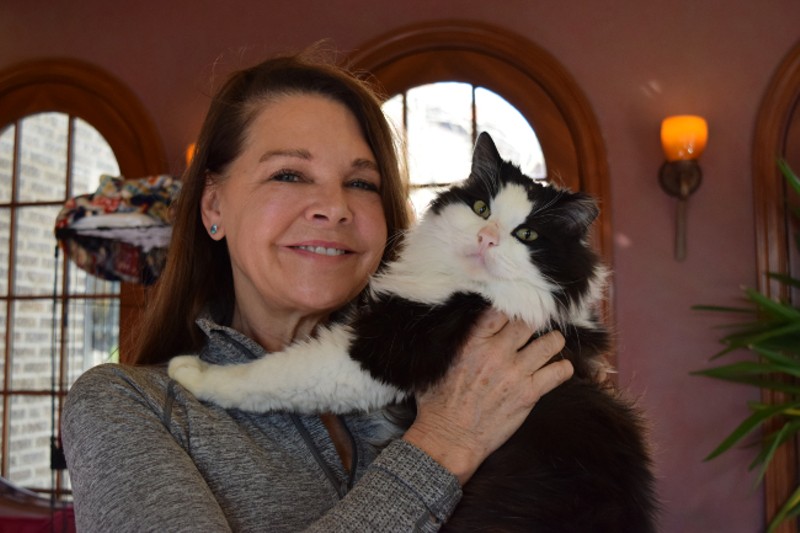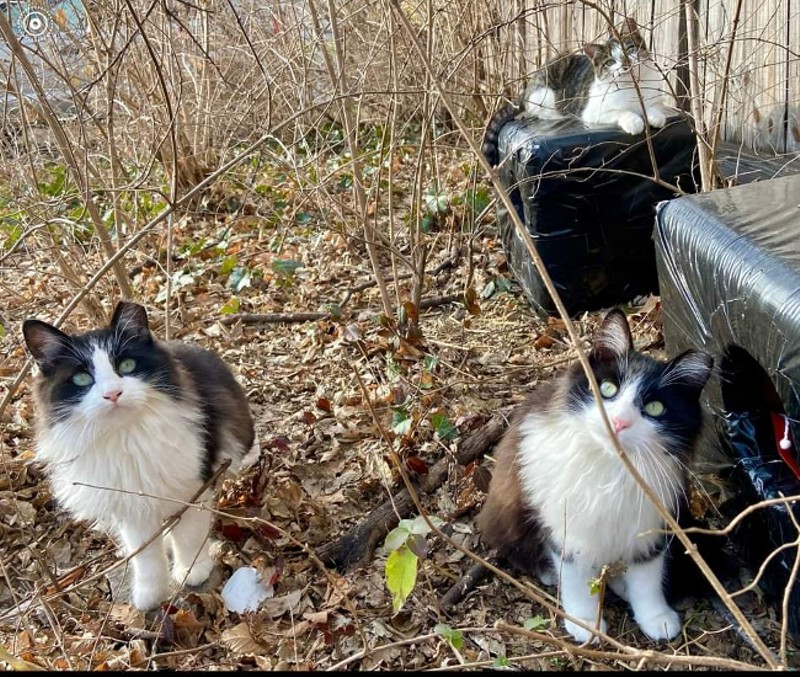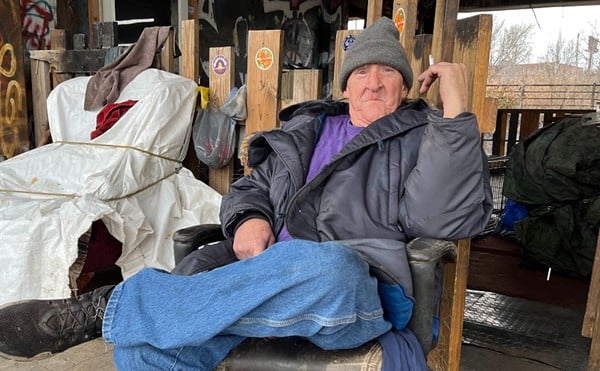
CASSIDY WAIGAND
Laura Mehard holds her foster Oreo, who once lived in a feral cat colony in St. Louis. Oreo's right ear has been clipped, indicating that he has been neutered.
On a recent morning in Laura Mehard’s home, furniture is covered with blankets, and curled inside a multilevel cat cage is a mound of black and white fur — Mehard's foster cat named Oreo.
Oreo is about to head to his new home. Before he arrived at Mehard’s place, he had lived for two years in a feral cat colony in St. Louis.
And as winter rolls through St. Louis, Mehard is worried about the feral cats who remain outdoors.
"Everybody's just scrambling," Mehard says, "just scrambling because they're gonna freeze to death. They're gonna die."
Mehard fosters for St. Louis Pet Rescue and helps care for feral colonies in St. Louis. Recently, she has been searching for shelters through the St. Louis Community Cat Winter Shelter Group on Facebook.
St. Louis Feral Cat Outreach formed the separate Facebook group in 2019. It was created so STLFCO and the community could find supplies for shelters and people could find shelters being made in their area, according to STLFCO board coordinator Katrina Wallis.
Christine Bowen is the board president of STLFCO. Normally, the nonprofit partners with the Thomas Dunn Learning Center for shelter-building events. Bowen says in the past, STLFCO has made more than 200 shelters during builds. During its last session, however, it made fewer than 100.
So Bowen started St. Louis Community Cat Winter Shelter Group as another resource. Since it started, Wallis says, the group has grown to about 1,400 people.
“It's really worked well because there's like probably three or four people, at least, who are not even volunteers of our group that get these boxes and make them and put them out and offer them to people,” Bowen says.
At its core, STLFCO is a Trap-Neuter-Return nonprofit. It works to help people trap feral cats, get them fixed and then return them to the area.
“If people see a new cat coming in, we recommend, especially during the cold, reaching out for shelter but then also reaching out to [STLFCO] so that we can guide them through the process of trapping,” Wallis says.
The city of St. Louis adopted Ordinance 69798 in 2014, which supported using TNR strategies on feral cat populations. Wallis says the STLFCO Facebook page directs people to different resources for TNR, winter shelters or rescues to reach out to if a cat is friendly.
The nonprofit will sometimes hear from people who are worried about feral cats around their home being cold, according to Wallis. She says the shelters, paired with TNR, help steer people away from wanting to relocate the cats.
“When they get [shelters], they noticed a difference. And they're a lot more happy and OK with that cat being outside because it does have a warm spot to go into at night,” Wallis says.
Wallis says STLFCO does not loan traps for bringing cats to animal control or relocating them. One big reason for that is that areas outside of the city — such as in Perry County where Wallis lives — do not have TNR ordinances.
In many instances, Wallis says these facilities will euthanize the cat. STLFCO believes “TNR is the only effective, humane solution for outdoor cats,” according to its website.
When it comes to relocation, Wallis says people who care for the feral cats are upset when they are relocated. Moreover, she says, many cats will not acclimate to the new environment and leave.
Websites such as Neighborhood Cats and Alley Cat Allies offer pages on humane deterrents for people who do not want cats in their yard. These include a variety of suggestions such as putting orange or lemon peels in gardens and buying a motion-activated sprinkler or ultrasonic deterrent.
Alley Cat Allies also recommends feral cat caretakers talk with neighbors and work together to try to address any concerns.
Mehard says she and others caring for feral cats in St. Louis try to be mindful of those living in the area. She says they work to get permission from people to put shelters outside their homes or try to place them in areas where people will not notice them.
While the caregivers have run into some instances of suspicious animal control employees coming around the site, Mehard says she thinks it is best to “kill them with kindness.”

LAURA MEHARD
Three feral cats in St. Louis sit outside of their shelters. Their clipped ears indicate they have been spayed or neutered.
Educating those in the area about the feral cats being spayed or neutered is also important, she says.
“These cats are not going to reproduce. They're not gonna fight — the males are not going to fight anymore,” Mehard says. “So, education is good, but we're very cautious, and we do not try to — like we don't even put a piece of trash in someone's dumpster. We feed them on corn tortillas, not paper plates.”
If Mehard or another one of the caretakers finds a friendly cat, she says, they ask people in the neighborhood if it belongs to anybody before taking it in to be adopted. According to Wallis, however, most feral cats older than six weeks cannot be socialized.
For those looking for shelters, Wallis recommends reaching out to the Facebook group. She says people may need to be patient when they first set up the shelter.
“Sometimes it takes a couple days for them to want to go with it, and sometimes you see cats laying on top of it or laying next to it, not necessarily climbing in it,” Wallis says. “It does take a while. But we also tell people that cats are very resourceful.”
Wallis says people who want to help can donate money or supplies to STLFCO for the shelter builds. Materials for shelters include Styrofoam coolers, tape, trash bags and straw. People could also donate time to transport materials or shelters.
“It could just be as simple as somebody saying, ‘Oh, hey, you know, I live right by where the shelter is, and you're not far from me. I can always go pick up the shelter and bring it to you,’” Wallis says.
Wallis says STLFCO is also looking for volunteers who can trap, transport or hold cats for TNR. In the end, Mehard says, a big part of helping out is educating others.
“If you feed them, you need to fix them and give them shelter,” Mehard says.





